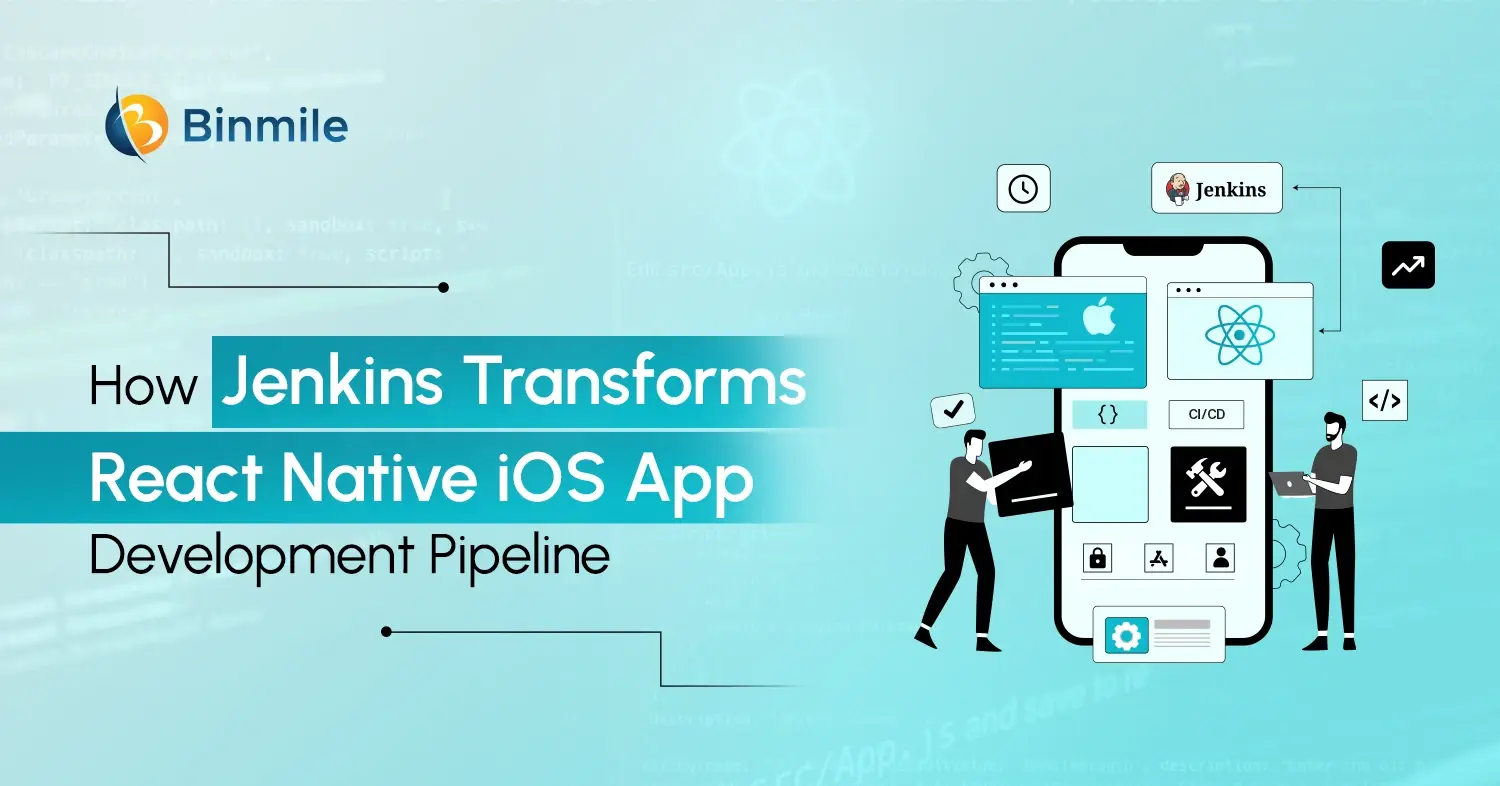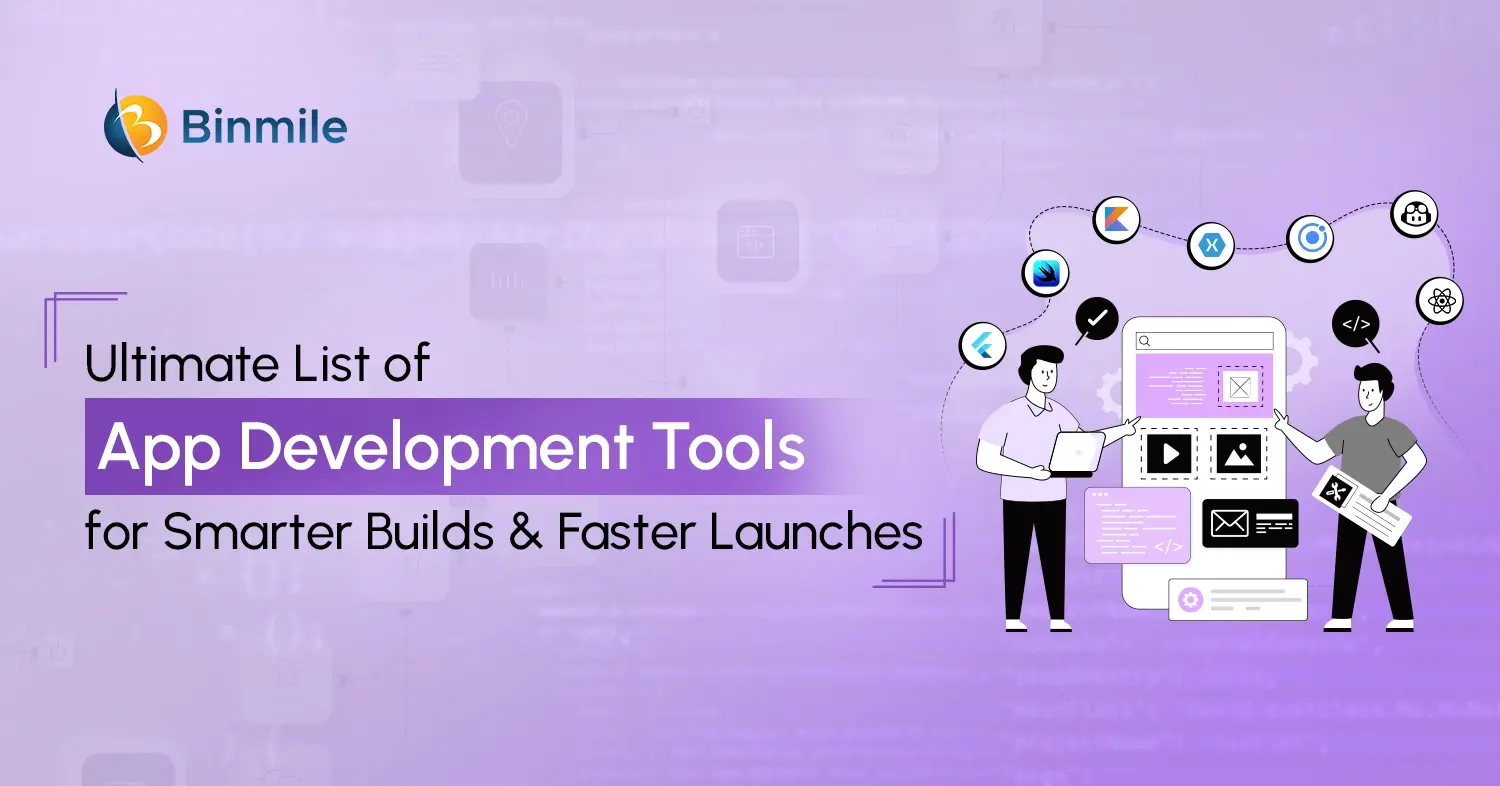Native and React Native development are two popular methods to build mobile apps. The latter is a multi-platform framework that enables developers to create apps for both Android and iOS operating systems using a single codebase. While the former focuses on developing separate apps for every platform using popular native programming languages and tools. But the question arises: Is it necessary to create a mobile app when your business is already operating ideally through a website? The answer is yes. The estimated revenue from the Application Development Software Market globally is expected to hit the USD 195.77 billion mark in 2025. So, if you don’t want to miss the golden opportunity to make a huge amount of money, hire a developer today to build React Native to Native apps for your business.
But a question arises, which one to choose among React Native vs Native for your mobile app development? Well, that’s what we are going to learn in this primer today. So, let’s begin:
What is a React Native Mobile Application?
React Native is the well-known open-source application development framework that was developed by Facebook. It allows developers to write UI using JSX components, a syntax extension that combines JavaScript and XML to define native-like UI elements declaratively. Since this popular app development framework provides a wide range of tools and widgets to create iOS and Android apps, developers can save a minimum of 40% to 90% time required for mobile app development.
| Benefits | Drawbacks |
|---|---|
| Code Reuse: React Native offers strong cross-platform compatibility, allowing developers to reuse the same codebase for Android and iOS, significantly reducing both time and cost | Performance: React Native mobile application may not perform as well as native applications, especially ones containing complex or graphics-intensive elements. |
| Large Community: This framework has a massive and active community of developers, which means you can access various resources to get started and troubleshoot problems. | Limited Features: Not all native features are available in this framework, so you may require writing code for a few components or features. |
| Fast Development: React Native mobile application can be built more quickly than native apps due to the use of JavaScript and React. For Android apps, enabling the lightweight Hermes engine can further improve performance by reducing startup time, memory usage, and overall app size | Debugging: Debugging RN apps can be more challenging than debugging native apps because of the extra layer of abstraction. |
What is a Native Mobile Application?
Native mobile app development refers to a software program that developers create for use on a specific platform or device. This is the main reason native apps can take advantage of device-centric hardware and software. Above all, these apps offer optimized performance and leverage cutting-edge technologies such as GPS compared to web apps or mobile cloud apps that are built to be generic across various systems.
| Benefits | Drawbacks |
|---|---|
| Performance: Native mobile app development usually performs better than React Native apps, especially ones comprising complicated or graphic-intensive components. | Code reuse: Native applications need separate codebases for Android and iOS operating systems. |
| Features: Native apps for Android can directly access hardware and features such as the microphone, camera, GPS, and push notifications to deliver a richer and more integrated experience. | Smaller community: Native development has a smaller community compared to React Native, so there may not be plenty of resources at your hand to help you get started and troubleshoot bugs. |
| Debugging: Debugging native apps is more effortless than debugging React Native apps. | Slower development: Native mobile app development is a time-consuming process compared to React Native as the former requires writing separate codebases for Android and iOS platforms. |
Key Differences Between React Native vs Native App Development
The key difference between the Native and React Native approaches is their interaction with device hardware. For instance, native mobile app development is done separately for iOS devices using Objective-C or Swift, while Android needs Java or Kotlin. This technique ensures direct access to all native features on every platform. Also, the cloud native applications market size globally is estimated to rise to USD 17.0 billion by 2028 from its valuation of USD 5.9 billion in 2023, showing the scope of native app development in the software industry.
On the other hand, you must know that React Native is driven by JavaScript and JSX (JavaScript XML) that helps developers build cross-platform apps functional across various platforms. Keeping this in mind is very important especially when you are considering transforming your app from React Native to Native. The “write once run anywhere” approach of React Native has been popular for a long time and this is what makes it preferred to native apps in the software industry.
React Native vs Native Apps: 7 Key Factors to Choose the Right Mobile App Development Approach
Here is a detailed look at some important factors to consider to make the right choice between React Native vs Native mobile app development.

1. Development Time
The first point to consider during the React Native to Native comparison is the development time. The latter method of mobile app development is quite time-intensive because it requires code to be written for both iOS and Android platforms separately. You need to have two different teams, like the iOS app development team and Android app development team to make your application available on both platforms.
Apart from that, you need to build and run the entire project whenever you make a change in the code, resulting in extra effort and time consumption. However, when it comes to React Native, a single code is written for both operating systems by the same developer to create Android and iOS apps.
2. UI/UX Experience
The next factor that helps to determine which is best among React Native vs Native is UI/UX experience. Although the React Native framework lets developers reuse the functionality code and write platform-centric code individually, building an intricate user interface including navigation patterns, custom views, and smooth transitions and animations is still challenging.
But that’s not the case with Native apps for Android and iOS platforms. Here every screen is designed separately for Android and iOS devices, leading to an enhanced UI/UX experience.
3. Performance
Another thing you must factor in React Native to Native comparison is the performance of the app. React Native operates on a single JavaScript thread, which limits its ability to handle multiple asynchronous tasks or UI operations simultaneously. This can result in dropped frames or delayed responses under high loads.. Aside from that the framework does not support various trending modules and functionalities. This limitation stems from the React Native bridge, which handles communication between the JavaScript thread and native modules. The asynchronous nature of this bridge can sometimes cause performance delays when accessing hardware-intensive features.
Whereas, Native applications are created using Java, Kotlin, or Swift that are way better than JavaScript to:
- Work on advanced features
- Make heavy calculations
- Incorporate advanced hardware devices
This makes it a breeze for developers to build any sort of application using native technologies which gives it an edge in React vs Native comparison.
4. Programming Language
The native programming languages for iOS and Android are Swift, Java, and Kotlin that are deemed to be strict-typed and OOP-oriented languages (Object-Oriented Programming System). They are a cakewalk to learn with comprehensive documentation and a bunch of rules and regulations, even though it takes time to master them.
On the other side, JavaScript seems easier to learn but contains multiple flaws and loopholes along with poor documentation. This makes it difficult for the developers of React Native apps for businesses to learn the language completely.
5. API & Library Support
Coming to API accessibility, the native app development frameworks can employ all types of APIs directly. Whereas, the same is not feasible with the React Native technology. The React Native applications can use only some APIs in their development processes. For implementing complicated Application Programming Interfaces, you need to develop a connection layer using native technologies. This clearly shows that Native is a better option than React Native in cross platform vs native app comparison when you need to add a lot of APIs.
6. Scalability
In the React Native to Native comparison, the former offers developers a wide range of opportunities to process extensive work in an application and release higher-functionality updates. React Native’s modular architecture helps developers organize code into reusable parts, speeding up updates and maintenance.
7. Long-Term Scope
The last thing you need to consider when making a selection between React Native vs Native mobile app development is long-term scope. Since the native platforms are supported by Google and Apple, they easily get the tools and resources to implement any functionality, fix issues, and launch updates without impacting app usability.
While frameworks like React Native do not prioritize updates. The tools and updates are not released at the pace of Apple and Google, making it unsuitable to develop and launch future updates. Beyond that, there is less chance of long-term support, which again makes one question whether they should choose React Native for a long-term app or not.
Are you torn between the sleek efficiency of native app development and the versatility of React Native? Discover which path leads to your app-building success!

Cost Comparison of React Native vs Native App Development
The tech stack you pick for your mobile app development can significantly impact the development cost as well as the time it takes to build. Approaching mobile app development with React Native can lower the cost by 30% to 35% in comparison to Native app development. Here’s how different technologies influence the cost when you decide to hire mobile app developer for your project:
Native Mobile App Development
- Cost Range: $40,000 to $250,000 or more
- Core Technologies: Kotlin (Android), Swift (iOS), Android SDK, Objective-C, Xcode, Firebase (backend)
React Native Mobile App Development
- Cost Range: $30,000 to $200,000 or more
- Core Technologies: React Native, Xamarin, Flutter, GraphQL, Firebase
Successful React Native Application Examples

1: Bloomberg
Bloomberg, a well-known financial news company, is one of those organizations that reaped the benefits of React Native for cross platform app development just to meet the needs of its consumer mobile application. The selection of React Native helped them simplify the process and allowed them to develop a high-performance app with enhanced navigation and real-time data updates.
2: Uber Eats
Among React Native vs Native development, the former proved to be the best option for food delivery app development like Uber Eats. Since the Uber team had expertise in the React ecosystem, their already huge infrastructure supported the shift to React Native. This framework also extended Uber’s options, combining web with mobile app development, and making sure that their developers could write features both in JavaScript and native language.
3: Meta
Previously known as Facebook, Meta hasn’t just created a tool for the masses but also a product it trusts and wants other developers to contribute to. The company was willing to accomplish web development with a single cross-platform team, quick iteration, and streamlined user experience on mobile platforms. So, Meta took the plunge to include all that into React Native for mobile app development.
4: Walmart
Everyone is familiar with Walmart and it is crystal clear over the past few years that they are making a solid effort to enhance their online infrastructure. One of their main challenges was to augment the performance and customer experience on both mobile applications. That’s when Walmart chose to go with React Native after comparing React Native to Native development.
Popular Native Application Examples

1: Spotify
Spotify, one of the Native apps for Android and iOS platforms, is a must-have application for music fans across the globe. Aside from that, Spotify is also considered an ideal example of a cloud-native application. It achieved performance efficiency in its workload due to Google Cloud, enabling the music-playing app to better serve its customers.
See how Binmile helped Spotify achieve seamless onboarding and improved HR process efficiency.
2: WhatsApp
Whatsapp is an extensively used messaging service application across the globe powered by native software for iOS and Android platforms. Just to let you know, this app was the fourth most downloaded app around the world in Q3 2020 with more than 140 million downloads. Resultantly, when it comes to excellent personal communication tools out there, this native app example is a practical solution in React Native vs Native app comparison.
3: Tesla
Another notable example of a native app is Tesla, which is widely known for its electric vehicles. Customers can drive their motor vehicles from a remote location using the Tesla smartphone app. You can also track how fast your automobile is charging and even start and stop it using the app itself.
4: Pokemon Go
Pokemon Go is an Augmented Reality mobile game that has emerged as the breakout hit in the 2016 App Store list. The gaming interface of the game is extensively simplified by turning the real world into a game map and transferring the control to players. The main objective of this Native mobile app development is to encourage players to travel the actual world. Thus, seasoned developers can gain a deep understanding of how to create immersive augmented reality experiences by going through the development process of Pokemon Go.
Want to save big on your mobile app project while ensuring top performance and scalability? Book a free 30-minute consultation with our experts today!

The Endnote: What is Best Among React Native vs Native?
After seeing React Native application examples, it seems that this framework is a better option for B2B services owing to its shorter development time and affordable price. React Native is especially popular among startups and businesses looking to develop a Minimum Viable Product (MVP) quickly and with limited resources While Native app development comes with optimum performance, advanced features, and easy debugging advantages, it requires more cost and time for full-fledged development. So, to make it easier for you to choose the right technology for your next app development, we have drafted a table below that will help you learn if React Native vs Native is an appropriate choice for your project.
| Aspects | Native | React Native |
|---|---|---|
| Do you need to develop an iOS-only or Android-only application? | Yes | No |
| Do you wish to maintain the app over a long period, without being scared of Facebook quitting React Native for mobile app development? | Yes | No |
| Do you want to make a highly complicated application which uses a large portion of platform-specific code? | Yes | No |
| Does your application need to support new operating system features as soon as they are launched? | Yes | No |
| Do you have a small team at your disposal with limited time and resources, and need to make an application for both platforms? | No | Yes |
| Do your developers have a solid React/ Web development background? | No | Yes |
| Do you want to make the most of quick build time, and features such
as hot reloading and live reloading? |
No | Yes |
| Is your app going to look and behave the same on both platforms? | No | Yes |
Finally, the query pops up: is React Native worth it, or is Native a more apt option? Well, the answer depends on your project. If you’re still unsure about your choice, book a free 30-minute consultation with our expert app development team to build your desired application.
Frequently Asked Questions
React Native and app development can lower costs by 30–35% compared to native development because a single codebase is used for both iOS and Android, reducing the need for separate teams and duplicated effort
React Native and app development offer faster development since one codebase works for both platforms, while native development requires separate codebases, increasing time and efforts
Native app development generally delivers better performance and smoother animations, while React Native may experience minor lags, especially in complex or resource-intensive applications
Native app development provides full access to device features and APIs, while React Native may have limitations or require additional plugins for advanced functionalities
Native app development is often preferred for long-term projects due to ongoing support and timely updates from Apple and Google, whereas React Native may lag in updates and long-term support









